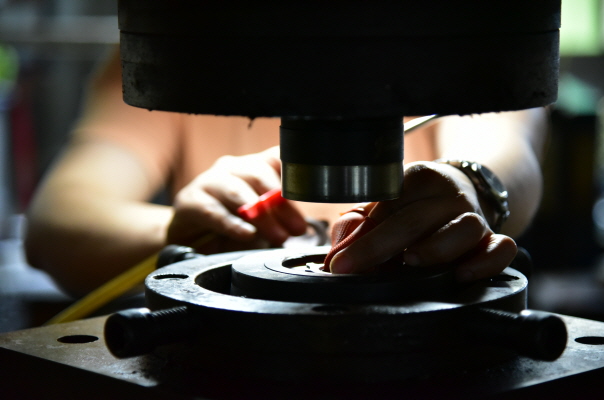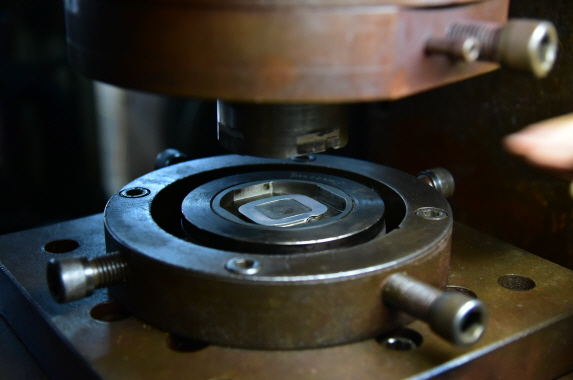

_실제 애플워치 베젤(Stainless steel) 단조 사진 촬영본
단조 공법이란?
단조 공정에 대한 심층 분석
단조는 금속을 망치나 프레스로 가열하거나 상온 상태에서 강하게 타격하여 원하는 형태로 성형하는 제조 공정입니다. 이 과정에서 금속의 내부 조직이 치밀해지고 강도가 향상되며, 복잡한 형태의 제품을 만들 수 있다는 장점이 있습니다.
단조 공정의 상세 과정
소재 준비:
- 단조에 사용될 금속 소재를 적절한 크기와 형태로 준비합니다. 일반적으로 봉재, 빌렛, 슬랩 등의 형태로 사용됩니다.
- 소재의 종류는 철, 알루미늄, 구리, 티타늄 등 다양하며, 제품의 특성에 따라 선택됩니다.
가열 (열간 단조의 경우):
- 소재를 단조 온도까지 가열합니다. 단조 온도는 사용하는 금속의 종류와 합금 성분에 따라 다릅니다.
- 가열은 가열로, 유도 가열 등 다양한 방법으로 이루어집니다.
초벌 단조:
- 가열된 소재를 단조기에 넣고 1차적으로 대략적인 형태를 만드는 과정입니다.
- 이 과정에서 소재의 결정립이 미세화되기 시작합니다.
재가열 (필요 시):
- 복잡한 형상의 제품을 만들기 위해 추가적인 단조가 필요한 경우, 재가열하여 소재의 가공성을 높입니다.
정밀 단조:
- 초벌 단조된 소재를 최종 형상으로 만드는 과정입니다.
- 정밀한 치수와 형상을 얻기 위해 다단계의 단조 공정이 필요할 수 있습니다.
열처리:
- 단조 후 열처리를 통해 잔류 응력을 제거하고, 기계적 성질을 향상시킵니다.
- 열처리 종류에는 풀림, 뜨임, 담금질 등이 있습니다.
마무리 가공:
- 절삭 가공, 연마 등 추가적인 가공을 통해 제품의 표면을 정밀하게 처리하고, 필요한 치수를 맞춥니다.
단조 공법의 종류
- 열간 단조: 고온 상태에서 금속을 단조하는 방식으로, 금속의 유동성이 높아 복잡한 형상을 만들기에 유리합니다.
- 냉간 단조: 상온 또는 저온 상태에서 금속을 단조하는 방식으로, 치수 정밀도가 높고 표면 품질이 우수합니다.
- 개방형 단조: 틀 없이 금속을 자유롭게 성형하는 방식으로, 대형 제품이나 특수 형상의 제품 생산에 적합합니다.
- 폐쇄형 단조: 틀을 사용하여 금속을 성형하는 방식으로, 정밀한 치수와 형상의 제품을 생산하는 데 적합합니다.
단조 공법의 장점과 단점
| 장점 | 단점 |
|---|---|
| 높은 강도와 내구성 | 높은 생산 비용 |
| 균일한 조직 | 생산 속도가 느림 |
| 다양한 재료 적용 | 복잡한 공정 |
| 긴 수명 | 금형 제작 비용이 높음 |
- 자동차 산업: 엔진 부품, 크랭크축, 커넥팅로드 등
- 기계 산업: 프레스 기계 부품, 베어링, 펌프 부품 등
- 항공 우주 산업: 엔진 부품, 랜딩 기어 부품 등
- 건설 산업: 철근, H형강 등
An in-depth analysis of forging processes
Forging is a manufacturing process in which metal is heated with a hammer or press or strongly struck at room temperature to form the desired shape. The advantage of this process is that the internal structure of the metal becomes denser, the strength is improved, and complex products can be made.
a detailed process of forging
Material Preparation:
Prepare the metal material to be used in forging in the appropriate size and shape. Generally used in the form of sewing, billet, slab, etc.
The types of materials are diverse, including iron, aluminum, copper, titanium, and are selected according to the characteristics of the product.
Heating (for hot forging):
Heat the material to forging temperature. Forging temperature depends on the type of metal and alloy composition used.
Heating takes place in a variety of ways, including heating furnaces, induction heating, and so on.
First Forging:
The process of putting the heated material in a forging machine and making a rough shape first.
In this process, the grains of the material begin to become finer.
Reheating (if required):
If additional forging is required to create a product of complex shape, reheat it to increase the workability of the material.
Precision Forging:
It is the process of making the first forged material into its final shape.
A multi-step forging process may be required to obtain precise dimensions and shapes.
Heat treatment:
Heat treatment after forging removes residual stress and improves mechanical properties.
Types of heat treatment include loosening, knitting, and tempering.
Finishing:
The surface of the product is precisely processed through additional processing such as cutting and polishing, and the required dimensions are adjusted.
Types of Forging Method
Hot forging: Forging metal at high temperatures, which is advantageous for creating complex shapes due to the high fluidity of the metal.
Cold forging: Forging metal at room temperature or low temperature with high dimensional precision and excellent surface quality.
Open forging: Free molding of metal without a frame, suitable for the production of large or special shapes.
Closed forging: A method of molding metal using a frame, suitable for producing products of precise dimensions and shapes.
문 의 하 기
GPS는 중국 현지 자체 공장에서 경쟁력 있는 단가와 납기로 고객사들에게 우수한 품질의 제품을 제공합니다. 이를 통해 글로벌 시장에서의 경쟁력을 강화하며, 고객의 요구에 맞춘 신속하고 효율적인 서비스로 만족을 드리고 있습니다. 최신 기술을 바탕으로 고품질의 부품을 합리적인 가격에 제공함으로써 고객사의 생산성 향상에 기여하고 있습니다 - GPKOREA
